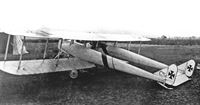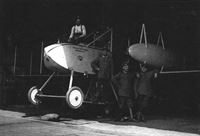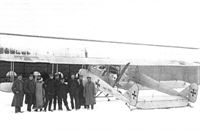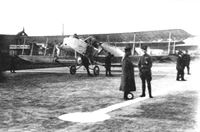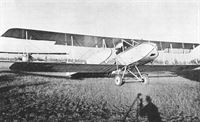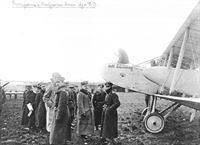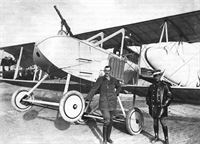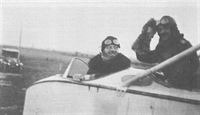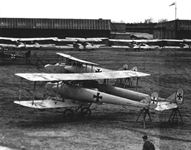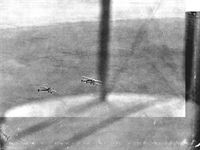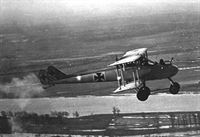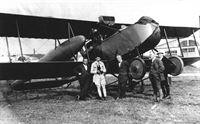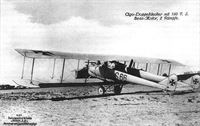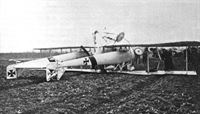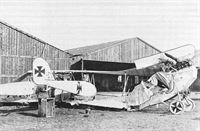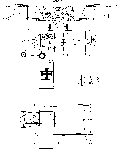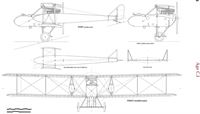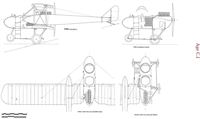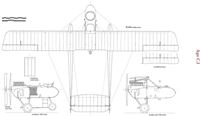
Описание
Страна: Германия
Год: 1915
Фронтовой самолет
Варианты
- AGO - C.I / C.II - 1915 - Германия
- AGO - C.IW / C.IIW - 1915 - Германия
- AGO - C.III - 1916 - Германия
- В.Кондратьев Самолеты первой мировой войны
- O.Thetford, P.Gray German Aircraft of the First World War (Putnam)
- J.Herris Otto, AGO and BFW Aircraft of WWI (A Centennial Perspective on Great War Airplanes 37)
- P.Grosz, G.Haddow, P.Shiemer Austro-Hungarian Army Aircraft of World War One (Flying Machines)
-
J.Herris - Otto, AGO and BFW Aircraft of WWI /Centennial Perspective/ (37)
Ago C.I prototype in original configuration, January/February 1915.
-
J.Herris - Otto, AGO and BFW Aircraft of WWI /Centennial Perspective/ (37)
Ago C.I prototype with final tail surfaces and assigned serial 1/15. Flown by Lt. Max Ihn and Oblt. Max Freiherr von und zu Fraunberg of F.FI.Abt. 6, April 1915.
-
В.Кондратьев - Самолеты первой мировой войны
AGO C-II, 9 (баварский) авиаотряд ВВС Германии, январь 1916г.
-
J.Herris - Otto, AGO and BFW Aircraft of WWI /Centennial Perspective/ (37)
Ago C.I 96/15 of Feld-Flieger Abteilung 9b. The pilot was Lt. Auer and the observer was Oblt. Paulin. Their names were painted on the rudder. The nose has been modified to carry a long-focal length camera.
-
J.Herris - Otto, AGO and BFW Aircraft of WWI /Centennial Perspective/ (37)
Ago C.I 97/15 of Feld-Flieger Abteilung 9b. The pilot was Vzfw. Bruno Chorbacher and the observer was Lt.d.R. Ludwig Schmidt. They were based at Flugplatz Colmar.
-
J.Herris - Otto, AGO and BFW Aircraft of WWI /Centennial Perspective/ (37)
Ago C.I LF181 Naval Air Service Nieuwmenster Aerodrome, 1915.
-
J.Herris - Otto, AGO and BFW Aircraft of WWI /Centennial Perspective/ (37)
The Ago C.I prototype photographed at Johannisthal when rolled out in January/February 1915. The tail had no fixed fins; these were added to production aircraft.The prototypes and first production series had side radiators. Power for the prototype was a 150hp Benz Bz.III. (Peter M. Grosz Collection/STDB)
-
J.Herris - Otto, AGO and BFW Aircraft of WWI /Centennial Perspective/ (37)
The Ago C.I prototype at Johannisthal in January/February 1915.The light yellow varnished tail booms appear dark due to the film used. (Peter M. Grosz Collection/STDB)
-
J.Herris - Otto, AGO and BFW Aircraft of WWI /Centennial Perspective/ (37)
The Ago C.I prototype was modified with the additional of vertical fins and new rudders, then given military serial C.1/15. This was first serial ever applied to an armed, two-seat biplane. According to Idflieg, this was also the first German aircraft armed with a Parabellum LMG 14 machine gun. In April 1915 the aircraft was assigned to Feld-Flieger Abteilung 6.There it was flown by Lt. Max Ihn (pilot) and Oblt. Max Freiherr von und zu Fraunberg as observer.
-
J.Herris - Otto, AGO and BFW Aircraft of WWI /Centennial Perspective/ (37)
Ago C.I C.1/15 after the tailplane was modified with fixed fins; it was then assigned to Feld-Flieger Abteilung 9b.
-
J.Herris - Otto, AGO and BFW Aircraft of WWI /Centennial Perspective/ (37)
Ago C.I C.96/15 of Feld-Flieger Abteilung 9b on the airfield. The front wheels have been removed from the undercarriage.
-
J.Herris - Otto, AGO and BFW Aircraft of WWI /Centennial Perspective/ (37)
Ago C.l 96/15; the black and white stripes are the unit marking of Armee-Abteilung Gaede. It was part of the third production batch that was powered by the 160 hp Mercedes D.III. (Peter M. Grosz Collection/STDB)
-
J.Herris - Otto, AGO and BFW Aircraft of WWI /Centennial Perspective/ (37)
Ago C.I 96/15 of Feld-Flieger Abteilung 9b undergoing minor maintenance. (Bruno Schmaling)
This view of Ago C.I 96/15 of Armee-Abteilung Gaede shows the Armee marking on both sides of the tail booms. (Peter M. Grosz Collection/STDB) -
J.Herris - Otto, AGO and BFW Aircraft of WWI /Centennial Perspective/ (37)
Ago C.I 96/15 of Feld-Flieger Abteilung 9b with assigned crew Lt. Hans Auer (pilot) and Oblt. Karl Paulin (observer).The small print on the rudder reads "Fuhrer Lt. Auer and Beob. Oblt. Paulin." The roundel dated 4-1-16 patched a French bullet hole. (Bruno Schmaling)
-
J.Herris - Otto, AGO and BFW Aircraft of WWI /Centennial Perspective/ (37)
Ago C.I 96/15 of Feld-Flieger Abteilung 9b with assigned crew Lt. Hans Auer (pilot) and Oblt. Karl Paulin (observer).The small print on the rudder reads "Fuhrer Lt. Auer and Beob. Oblt. Paulin." The roundel dated 4-1-16 patched a French bullet hole. (Bruno Schmaling)
-
J.Herris - Otto, AGO and BFW Aircraft of WWI /Centennial Perspective/ (37)
Ago C.I 96/15 was powered by a 160 hp Mercedes D.III. The black and white markings were those of Armee-Abteilung Gaede for the purpose of air-to-air identification to avoid attack by other German aircraft. These markings were seen as vertical black/white bands on other aircraft types. (Peter M. Grosz Collection/STDB)
-
J.Herris - Otto, AGO and BFW Aircraft of WWI /Centennial Perspective/ (37)
Observer Oblt. Karl Paulin and pilot Lt. Hans Auer pose in their assigned aircraft, Ago C.I 96/15.The black and white stripes are the unit marking of Bavarian Feld-Flieger Abteilung 9b. It was part of the third production batch that was powered by the 160 hp Mercedes D.III. (Peter M. Grosz Collection/STDB)
-
J.Herris - Otto, AGO and BFW Aircraft of WWI /Centennial Perspective/ (37)
Ago C.I C.96/15 of Feld-Flieger Abteilung 9b before the front wheels were removed from the undercarriage.
-
J.Herris - Otto, AGO and BFW Aircraft of WWI /Centennial Perspective/ (37)
Ago C.I; it is probably 96/15 but the serial is not legible. (Peter M. Grosz Collection/STDB)
-
J.Herris - Otto, AGO and BFW Aircraft of WWI /Centennial Perspective/ (37)
Ago C.I 96/15 of Bavarian Feld-Flieger Abteilung 9b. Carl Hailer (at right) called this photo the Ski Abteilung 9b. (Peter M. Grosz Collection/STDB)
-
J.Herris - Otto, AGO and BFW Aircraft of WWI /Centennial Perspective/ (37)
Ago C.I 98/15 ready for take-off in the winter Vosges hills. It has the markings of Armee-Abteilung Gaede and is probably from Bavarian FFA 9b. (Peter M. Grosz Collection/STDB)
-
J.Herris - Otto, AGO and BFW Aircraft of WWI /Centennial Perspective/ (37)
Ago C.I 100/15, aircrew, and ground crew. (Mike O'Neal)
-
J.Herris - Otto, AGO and BFW Aircraft of WWI /Centennial Perspective/ (37)
Ago C.I C.103/15 of Feld-Flieger Abteilung 9b. Unit markings have not yet been applied.
-
J.Herris - Otto, AGO and BFW Aircraft of WWI /Centennial Perspective/ (37)
Ago C.I 371/15 outside the Ago factory at Johannisthal. (Peter M. Grosz Collection/STDB)
-
J.Herris - Otto, AGO and BFW Aircraft of WWI /Centennial Perspective/ (37)
Ago C.I 371/15 outside the Ago factory at Johannisthal. (Peter M. Grosz Collection/STDB)
-
J.Herris - Development of German Warplanes in WWI /Centennial Perspective/ (1)
AGO C II на заводском дворе. Кресты нанесены с обеих сторон руля поворота.
Ago C.I 371/15 of the penultimate production batch.
The Ago C.I was one of the few German pusher designs; engines used were the 150 hp Benz, 160 hp Mercedes, or 160 hp Maybach Mb.III.
The intriguing twin-boom fuselaged Ago C II of late summer 1915 origins employed the same basic layout as the Ago C I, but used the 220hp Benz Bz IV. Only built in relatively modest numbers, the Ago C II began to be deployed at the end of 1915 and operated on the Western Front. The type's top level speed was quoted as 86 mph at sea level. -
K.Delve - World War One in the Air /Crowood/
The AGO CII was designed as a reconnaissance aircraft and appeared in late 1915. The sleek aerodynamic shape and twin-boom configuration made the type quite distinctive.
-
J.Herris - Otto, AGO and BFW Aircraft of WWI /Centennial Perspective/ (37)
Ago C.I C.1909/15 in the snow with crew men. (Reinhard Zankl)
-
J.Herris - Otto, AGO and BFW Aircraft of WWI /Centennial Perspective/ (37)
Ago C.I getting ready to fly.
-
J.Herris - Otto, AGO and BFW Aircraft of WWI /Centennial Perspective/ (37)
AGO C.I of Feld-Flieger Abteilung 61. (Bruno Schmaling)
-
J.Herris - Otto, AGO and BFW Aircraft of WWI /Centennial Perspective/ (37)
Ago C.I with engine running.
-
J.Herris - Otto, AGO and BFW Aircraft of WWI /Centennial Perspective/ (37)
Ago C.I of Feld-Flieger Abteilung 9b with two-wheel undercarriage. (Bruno Schmaling)
-
J.Herris - Otto, AGO and BFW Aircraft of WWI /Centennial Perspective/ (37)
Ago C.I powered by a 160 hp Mercedes D.III. Despite the greater power, performance was improved only modestly.
-
J.Herris - Otto, AGO and BFW Aircraft of WWI /Centennial Perspective/ (37)
Ago C.I S.158 was one of the Ago aircraft purchased by the Navy.
-
J.Herris - Otto, AGO and BFW Aircraft of WWI /Centennial Perspective/ (37)
Ago C.I transferred to the Navy at Nieuwmenster in Belgium in 1915. The original Army serial has been replaced by LF 181 (LF = Landflugzeug). (Peter M. Grosz Collection/STDB)
-
J.Herris - Otto, AGO and BFW Aircraft of WWI /Centennial Perspective/ (37)
Ago C.I LF 181 was assigned to the Navy. The red identification pennants used on German seaplanes is attached to the lower wing tips.
-
J.Herris - Otto, AGO and BFW Aircraft of WWI /Centennial Perspective/ (37)
Ago C.I of Feld-Flieger Abteilung 9b with ground crew.
-
J.Herris - Otto, AGO and BFW Aircraft of WWI /Centennial Perspective/ (37)
Ago C.I of Feld-Flieger Abteilung 9b.
-
J.Herris - Otto, AGO and BFW Aircraft of WWI /Centennial Perspective/ (37)
AGO C.I of Feld-Flieger Abteilung 62. (Bruno Schmaling)
-
J.Herris - Otto, AGO and BFW Aircraft of WWI /Centennial Perspective/ (37)
Ago C.I and crewmen of Armee-Abteilung Gaede. The aircrew liked the docile, reliable Ago C.I and flew it for months until the air combat environment became too hostile. (Peter M. Grosz Collection/STDB)
-
J.Herris - Otto, AGO and BFW Aircraft of WWI /Centennial Perspective/ (37)
The crew poses in the snow with their Ago C.I. The observer had an unrestricted field of fire forward but, like all pushers, was vulnerable to attack from behind and below. Despite the streamlined tail booms the design was comparatively high drag compared to its tractor contemporaries and was thus relatively slow. (Peter M. Grosz Collection/STDB)
-
J.Herris - Otto, AGO and BFW Aircraft of WWI /Centennial Perspective/ (37)
Early Ago C.I with side radiators of Feldflieger-Abteilung 23 was crewed by Ltn. Walter Sieber (pilot) and Ltn. Spatz (observer).The photo was taken at Roupy. (Peter M. Grosz Collection/STDB)
-
J.Herris - Otto, AGO and BFW Aircraft of WWI /Centennial Perspective/ (37)
Rudolf Berthold (right) poses with Ernst Schlegel in front of an AGO C.I at Armee-Flug-Park (formerly Etappen Flugzeug-Park) 2's airfield near Bellenglise.
-
J.Herris - Otto, AGO and BFW Aircraft of WWI /Centennial Perspective/ (37)
An Ago C.I of Feld-Flieger Abteilung 8b.The officer is Hptm. Schmoger. Attached to the nose is a test setup involving a radiator. Is this an evaluation of the radiator from a new vendor or new design? (Bruno Schmaling)
-
J.Herris - Otto, AGO and BFW Aircraft of WWI /Centennial Perspective/ (37)
An Ago C.I of Feld-Flieger Abteilung 8b.The radiator test setup is attached to the nose. (Bruno Schmaling)
-
J.Herris - Otto, AGO and BFW Aircraft of WWI /Centennial Perspective/ (37)
Oblt. Rudolf Berthold sits in the aft cockpit of an Ago C.I with Oblt. Fritz Bohmer as his observer. Mounted on the nose of the plane just in front of Bohmer's windscreen is what appears to have been a goose figure as a good luck charm
-
J.Herris - Otto, AGO and BFW Aircraft of WWI /Centennial Perspective/ (37)
Early Ago C.I of Feld-Flieger Abteilung 23 with side radiators. The crew was Lt. Walter Sieber (pilot) and Lt. Spatz (observer), and the photo was taken at Roupy. Note the observer's wind screen, which was mounted on the gun ring, has been turned out of the way as the observer bringing the gun into firing position. (Bruno Schmaling)
-
J.Herris - Otto, AGO and BFW Aircraft of WWI /Centennial Perspective/ (37)
Ago C.i of Feld-Flieger Abteilung 9b. (Bruno Schmaling)
-
J.Herris - Otto, AGO and BFW Aircraft of WWI /Centennial Perspective/ (37)
Ago C.I of Armee-Abteilung Gaede. (Peter M. Grosz Collection/STDB)
-
J.Herris - Otto, AGO and BFW Aircraft of WWI /Centennial Perspective/ (37)
From its unit markings this Ago C.I appears to be from Feld-Flieger Abteilung 9b but FFA 5b is also possible. Use of a tent hangar indicates the unit is at the front. (Bruno Schmaling)
-
J.Herris - Otto, AGO and BFW Aircraft of WWI /Centennial Perspective/ (37)
Ago C.I C.1/15 with Lt. Max Ihn (pilot) and Oblt. Max Freiherr von und zu Fraunberg as observer flying with FFA 6.
-
J.Herris - Otto, AGO and BFW Aircraft of WWI /Centennial Perspective/ (37)
An Ago C.I of Feld-Flieger Abteilung 8b flown by pilot Uffz. Wilhelm and observer Oblt. Rudolf Schonger. (Bruno Schmaling)
-
J.Herris - Otto, AGO and BFW Aircraft of WWI /Centennial Perspective/ (37)
Bavarian pilot Otto Kissenberth flying his Ago C.I.
-
J.Herris - Otto, AGO and BFW Aircraft of WWI /Centennial Perspective/ (37)
Ago C.I perhaps from FliegerAbteilung 48. A storm is blowing the tents around. (Bruno Schmaling)
-
J.Herris - Otto, AGO and BFW Aircraft of WWI /Centennial Perspective/ (37)
Ago C.I aircraft from Feld-Flieger Abteilung 9b before application of unit markings. (Bruno Schmaling)
-
J.Herris - Otto, AGO and BFW Aircraft of WWI /Centennial Perspective/ (37)
Ago C.I reconnaissance aircraft of Feld-Flieger Abteilung 9b are lined up on the airfield.
-
J.Herris - Otto, AGO and BFW Aircraft of WWI /Centennial Perspective/ (37)
A line up of AGO C.I and Aviatik C.I aircraft of Feld-Flieger Abteilung 68. (Bruno Schmaling)
Другие самолёты на фотографии: Aviatik C.I/C.Ia - Германия - 1915
-
J.Herris - Otto, AGO and BFW Aircraft of WWI /Centennial Perspective/ (37)
Unit line up of Ago C.I and Aviatik C.I aircraft.
Другие самолёты на фотографии: Aviatik C.I/C.Ia - Германия - 1915
-
J.Herris - Otto, AGO and BFW Aircraft of WWI /Centennial Perspective/ (37)
Другие самолёты на фотографии: Aviatik C.I/C.Ia - Германия - 1915
-
J.Herris - Otto, AGO and BFW Aircraft of WWI /Centennial Perspective/ (37)
Ago C.I aircraft and Pfalz Eindeckers in a wooden hangar.
Другие самолёты на фотографии: Pfalz E.I/E.II/E.IV/E.VI - Германия - 1915
-
J.Herris - Otto, AGO and BFW Aircraft of WWI /Centennial Perspective/ (37)
Flieger-Abteilung 16 line up of Ago C.I aircraft with tractor C-types in the background.
-
J.Herris - Otto, AGO and BFW Aircraft of WWI /Centennial Perspective/ (37)
Ago C.I aircraft in the left background serve with a battleplane, an AEG G.II. (Peter M. Grosz Collection/STDB)
Другие самолёты на фотографии: AEG G.I/G.II/G.III - Германия - 1915
-
J.Herris - Otto, AGO and BFW Aircraft of WWI /Centennial Perspective/ (37)
An Ago C.I is in the right background with a Fokker D.II in the foreground. (Peter M. Grosz Collection/STDB)
Другие самолёты на фотографии: Fokker D.II / M.17 - Германия - 1916
-
J.Herris, J.Leckscheid - Fokker Aircraft of WWI. Vol.3: Early Biplane Fighters /Centennial Perspective/ (53)
An Ago C.I seen in the background of this photo invites suggestion that the two aircraft in the photo may have served with Feld-Flieger Abteilung 9b in Colmar, a unit which is known to have operated both types. This unit became Jasta 16b in October 1916. The upper surfaces of the wings, horizontal tailplane, and the fuselage decking of Fokker D.II 540/16 (w/n 832) are painted in the new two-color factory-applied camouflage scheme. This may have been the first D.II to receive this new style of camouflage at Schwerin.
Другие самолёты на фотографии: Fokker D.II / M.17 - Германия - 1916
-
J.Herris - Pfalz Aircraft of WWI /Centennial Perspective/ (5)
A Pfalz E.II heads a lineup including two Fokker E.IIIs, a Pfalz A.II, and an Ago C.I (or C.II) of Feld-Flieger Abteilung 9b.
Другие самолёты на фотографии: Fokker E.I / E.II / E.III / M.14 - Германия - 1914Pfalz A.I/E.III - Германия - 1914Pfalz E.I/E.II/E.IV/E.VI - Германия - 1915
-
J.Herris, J.Scott - Fokker Aircraft of WWI. Vol.2: Eindeckers /Centennial Perspective/ (52)
E.33/15 eventually had Eiserne Kreuze applied onto the white portion of the fuselage band. The rudder was painted black as per AA Gaede practice. The Ago C.I in the background also exhibits the unit's sash marking. (Greg VanWyngarden)
Другие самолёты на фотографии: Fokker E.I / E.II / E.III / M.14 - Германия - 1914
-
A.Imrie - German Bombers /Arms & Armour/
The Ago C I twin-boom pusher had an auxiliary double wheel landing gear approximately under the observer's front seat, but Hauptmann Hailer of Flieger Abteilung 9b had this removed from his unit's machines so that a simple rack could be installed to carry Carbonit bombs. Some pilots in other units devised means of carrying bombs under their aeroplanes by removing the claw brake usually fitted to the undercarriage spreader bar, but a number of minor accidents because of this resulted in an order forbidding 'unauthorized modifications'.
-
J.Herris - Otto, AGO and BFW Aircraft of WWI /Centennial Perspective/ (37)
Detailed rear view of an Ago C.I powered by a 160 hp Mercedes D.III. (Peter M. Grosz Collection/STDB)
-
J.Herris - Otto, AGO and BFW Aircraft of WWI /Centennial Perspective/ (37)
Rear view of an Ago C.I powered by a 160 hp Mercedes D.III. (Peter M. Grosz Collection/STDB)
-
J.Herris - Otto, AGO and BFW Aircraft of WWI /Centennial Perspective/ (37)
Ago C.I 100/15 tail detail before the crash. (Mike O'Neal)
-
J.Herris - Otto, AGO and BFW Aircraft of WWI /Centennial Perspective/ (37)
The take-off of an Ago C.I of Feld-Flieger Abteilung 8b. The aircraft has a two-wheel undercarriage. (Bruno Schmaling)
-
J.Herris - Otto, AGO and BFW Aircraft of WWI /Centennial Perspective/ (37)
Ago C.I of Feld-Flieger Abteilung 9b taking off from the Colmar airfield.
-
J.Herris - Otto, AGO and BFW Aircraft of WWI /Centennial Perspective/ (37)
Unknown Ago C.I in flight; may be an enlargement of the facing photo of C.I of Feld-Flieger Abteilung 9b taking off from Colmar.
-
J.Herris - Otto, AGO and BFW Aircraft of WWI /Centennial Perspective/ (37)
Ago C.I in flight. Pushers offered unrestricted fields of view forward but were vulnerable in air to air combat. (Peter M. Grosz Collection/STDB)
-
J.Herris - Otto, AGO and BFW Aircraft of WWI /Centennial Perspective/ (37)
Ago C.I in flight.
-
J.Herris, J.Scott - Fokker Aircraft of WWI. Vol.2: Eindeckers /Centennial Perspective/ (52)
A Naval Eindecker is seen riding shotgun on an Ago C.I. (Peter M. Grosz collection/STDB)
Другие самолёты на фотографии: Fokker E.I / E.II / E.III / M.14 - Германия - 1914
-
J.Herris - Otto, AGO and BFW Aircraft of WWI /Centennial Perspective/ (37)
Air-to-air photo of an Ago C.I in flight.
-
J.Herris - Otto, AGO and BFW Aircraft of WWI /Centennial Perspective/ (37)
Ago C.I C.9X/15 of Feld-Flieger Abteilung 9b over the front.
-
J.Herris - Otto, AGO and BFW Aircraft of WWI /Centennial Perspective/ (37)
Ago C.I in flight. (Bruno Schmaling)
-
J.Herris - Otto, AGO and BFW Aircraft of WWI /Centennial Perspective/ (37)
An Ago C.I photographed in flight shows the structure through the translucent fabric. The insignia are painted over square white backgrounds. (Peter M. Grosz Collection/ STDB)
-
J.Herris - Otto, AGO and BFW Aircraft of WWI /Centennial Perspective/ (37)
Ago C.I aircraft of FFA 9b modified to carry a long focal length camera. Lt Hans Kuchler was the observer and Vzfw. Dorner was the pilot. (Peter M. Grosz Collection/STDB)
-
J.Herris - Otto, AGO and BFW Aircraft of WWI /Centennial Perspective/ (37)
Carl Hailer installing a 120 cm focal length camera in a modified Ago C.I. (Peter M. Grosz Collection/ STDB)
-
J.Herris - Otto, AGO and BFW Aircraft of WWI /Centennial Perspective/ (37)
On 10 July 1919, Ago C.I (D-118) arrived in Holland. The letters LB 2 (Lich T Bild 2) and a five-pointed star are under the left wing. The leading edge radiator was from a Rumpler. (Peter M. Grosz Collection/STDB)
-
J.Herris - Otto, AGO and BFW Aircraft of WWI /Centennial Perspective/ (37)
On 10 July 1919, Ago C.I (D-118) arrived in Holland. The letters LB 2 (Lich T Bild 2) and a five-pointed star are under the left wing. The leading edge radiator was from a Rumpler. (Peter M. Grosz Collection/STDB)
-
J.Herris - Otto, AGO and BFW Aircraft of WWI /Centennial Perspective/ (37)
Ago C.I LB2 postwar modified with a Rumpler leading edge radiator replacing the standard airfoil radiator. It was photographed in Holland. (Peter M. Grosz Collection/STDB)
-
J.Herris - Otto, AGO and BFW Aircraft of WWI /Centennial Perspective/ (37)
Postwar view of a modifed Ago C.I with non-standard leading edge radiator photographed in Holland showing the markings LB 2 on the tail boom. Civil registration D-118 was added to the fin later. Suppressed national markings on the upper wing suggests this C.I was the one intended for firing trails of the 2 cm Becker cannon in late 1918. (Peter M. Grosz Collection/STDB)
-
O.Thetford, P.Gray - German Aircraft of the First World War /Putnam/
Ago C II (three-bay)
-
J.Herris - Otto, AGO and BFW Aircraft of WWI /Centennial Perspective/ (37)
S.66 was an Ago C.II assigned to the Navy. The text on the nose appears to read "Schneewittchen" or 'Snow White.' This name was applied to a number of early German two-seaters that were finished in a pale color. (Peter M. Grosz Collection/STDB)
-
J.Herris - Otto, AGO and BFW Aircraft of WWI /Centennial Perspective/ (37)
Another view of Ago C.II S.66 assigned to the Navy was made into a postcard. (Michael Dosing)
-
A.Imrie - German Naval Air Service /Arms & Armour/
AGO C-I одной из разведывательных эскадр германского военно-морского флота.
Since the first naval landplanes were training machines, or Schulflugzeuge, they were allocated consecutive serial numbers prefixed by the letter 'S'. This system was continued on all naval landplanes, which naturally included front-line machines, until October 1915 when all naval landplanes were given the more appropriate prefix of the letters 'LF', meaning Land Flugzeug. This is an Ago C I pusher twin-boom biplane seen at Johannisthal before the prefix change. -
J.Herris - Otto, AGO and BFW Aircraft of WWI /Centennial Perspective/ (37)
Overhead view of the Ago C.II. The three-bay, long-span wings are clearly shown. (Peter M. Grosz Collection/STDB)
-
J.Herris - Otto, AGO and BFW Aircraft of WWI /Centennial Perspective/ (37)
Ago C.II LF.67. was a Naval aircraft.
-
J.Herris - Otto, AGO and BFW Aircraft of WWI /Centennial Perspective/ (37)
Ago C.I 371/15 of Bavarian Feld-Flieger Abteilung 9b was hit by anti-aircraft fire during a mission in September 1916 with this result. The crew was pilot Unteroffizier Ludwin Hilz and observer Leutnant Alois Simson. This close-up shows the bracing strut and the fact the fin was suspended above the tail boom.The tail cross was painted on both sides of the rudder. (Peter M. Grosz Collection/STDB)
-
J.Herris - Otto, AGO and BFW Aircraft of WWI /Centennial Perspective/ (37)
Ago C.I C.1/15 after a collision with an automobile. Additional cross-bracing has been added to the center section.
-
J.Herris - Otto, AGO and BFW Aircraft of WWI /Centennial Perspective/ (37)
Another view of Ago C.I C.1/15 after a collision with an automobile
-
J.Herris - Otto, AGO and BFW Aircraft of WWI /Centennial Perspective/ (37)
Crash of an unidentified Ago C.I.
-
J.Herris - Otto, AGO and BFW Aircraft of WWI /Centennial Perspective/ (37)
Crash of an Ago C.I; the four-wheel undercarriage was safer than the usual two-wheel undercarriage but rough terrain could still cause landing accidents.
-
J.Herris - Otto, AGO and BFW Aircraft of WWI /Centennial Perspective/ (37)
Ago C.I 7/15 after landing on a plowed field. It was from Bavarian FFA 9b and has the markings of Armee-Abteilung Gaede. (Peter M. Grosz Collection/STDB)
-
J.Herris - Otto, AGO and BFW Aircraft of WWI /Centennial Perspective/ (37)
Ago C.I 100/15 after the crash. (Mike O'Neal)
-
J.Herris - Otto, AGO and BFW Aircraft of WWI /Centennial Perspective/ (37)
The crash of Ago C.I 349/15 of Feld-Flieger Abteilung 9b. The engine quit on take-off and the result was disaster. In such an event the engine would plow into the crew's back. Carl Hailer was pilot of this aircraft and, an excellent athlete, saved his life by jumping free of his cockpit just before impact. (Bruno Schmaling)
-
J.Herris - Otto, AGO and BFW Aircraft of WWI /Centennial Perspective/ (37)
Ago C.I 354/15 of Feld-Flieger Abteilung 8b after a ground collision. (Bruno Schmaling)
-
J.Herris - Otto, AGO and BFW Aircraft of WWI /Centennial Perspective/ (37)
The crash of Ago C.I 370/15 of Feld-Flieger Abteilung 9b on Oct. 25,1916. The crew was Lt. Biederrmann and Vzfw. Ertl. (Bruno Schmaling)
-
J.Herris - Otto, AGO and BFW Aircraft of WWI /Centennial Perspective/ (37)
The wreck of an Ago C.I of Feld-Flieger Abteilung 8b. (Bruno Schmaling)
-
J.Herris - Weird Wings of WWI /Centennial Perspective/ (70)
The AGO C.I was the first C-type armed two-seater introduced into Fliegertruppe service, mainly with Bavarian units. It had some advanced construction features.
-
J.Herris - Otto, AGO and BFW Aircraft of WWI /Centennial Perspective/ (37)
This document from Feld-Flieger Abteilung 9b shows the unit markings of the Ago C.I starting in 1915. Feld-Flieger Abteilung 9b was part of Armee-Abteilung Gaede and the black and white bands were specified by Armee-Abteilung Gaede for the purpose of air-to-air identification to avoid attack by other German aircraft. The Otto C.I and Ago C.I resembled French pushers from a distance in the air and the black/white bands were intended to enable German aircraft to identify other German aircraft in the air. The Pfalz and Fokker Eindeckers resembled Morane-Saulnier Bullets in the air. Diagonal black/white bands were also used on other aircraft types such as Aviatik B- and C-types, AEG C-types, Pfalz Parasols, Fokker Eindeckers, and AEG G.IIs. These markings were also seen as vertical black/white bands on other aircraft types such as Aviatik B- and C-types, Pfalz Eindeckers, Fokker Eindeckers, and AEG G.IIs. So the use of diagonal black/white bands around the fuselage indicates the aircraft was attached to Armee-Abteilung Gaede, not specifically to Feld-Flieger Abteilung 9b. (Greg VanWyngarden)
В.Кондратьев Самолеты первой мировой войны
AGO C-I/C-II/C-III
В начале 1915 года швейцарские инженеры Хайфель и Шорп, работавшие на берлинской фирме Аэроверк Густав Отто (AGO), разработали двухместный военный аэроплан, приспособленный для установки пулемета.
Аэродинамическая схема машины - двухбалочный биплан с толкающим винтом - была уникальна для тогдашней германской авиации. Легкие и прочные фюзеляжные балки выклеивались из шпона. Гондола имела деревянный каркас и фанерную обшивку. Деревянный силовой набор крыла и стабилизатора покрывался полотном.
Самолет, обозначенный AGO C-I, появился на западном фронте в июне 1915-го. Единственный на тот момент немецкий аэроплан с носовой пулеметной турелью поначалу вызвал удивление и страх среди пилотов Антанты. Тем более, что большинство английских и французских машин было тогда вообще безоружно. В сочетании с довольно высокой скоростью это позволило без опаски посылать AGO на любые задания. Экипажи ценили "двуххвостки" за легкость пилотирования, хорошие взлетно-посадочные характеристики и отличный обзор.
Следующая модификация AGO C-II оснащалась более мощным мотором. Размах крыльев уменьшили на одну секцию, превратив трехстоечный биплан в двухстоечный.
Последним в этой серии стал C-III - одностоечный биплан, по размерам близкий к истребителям, оборудованный простой двухколесной тележкой шасси.
Он начал поступать на фронт уже в то время, когда сама концепция подобных машин перешла в разряд устаревших. Немецкие "рамы" с задним расположением двигателя оказались столь же беззащитны от истребителей, как французские "Фарманы" и "Вуазены".
Тем не менее, AGO продержались во фронтовых разведывательных частях довольно долго, примерно до середины 1917 года.
Примечательно, что многие пилоты, покоренные удобством и послушностью "двуххвосток", до последней возможности отказывались пересаживаться на более современные машины, несмотря на повышенный риск быть сбитыми.
ДВИГАТЕЛЬ
"Мерседес", 160 л.с. (С-I и C-III) или "Бенц", 220 л.с. (C-II).
ВООРУЖЕНИЕ
1 турельный "Парабеллум", до 50 кг бомб.
ЛЕТНО-ТЕХНИЧЕСКИЕ ХАРАКТЕРИСТИКИ
Размах, м 14,50
Длина, м 9,84
Площадь крыла, кв.м 40,80
Сухой вес, кг 845
Взлетный вес, кг 1360
Скорость максимальная, км/ч 137
Время набора высоты, м/мин 3000/30
Потолок, м 4500
Описание:




















